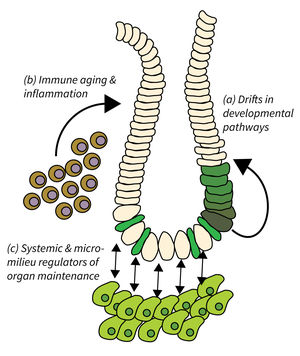Subarea 2: Regeneration and Homeostasis of Organs in Aging
The main goal of Subarea 2 is to identify cellular and molecular pathways used to ensure effective organ maintenance and repair, and to unravel the mechanisms of their deterioration during aging. While stem cells are important for organ homeostasis, this Subarea does not per se directly addresses stem cell aging but rather focusses on the following focus areas:
- Drifts in developmental pathways limiting organ maintenance in aging,
- Immune aging and inflammation, and
- Systemic and micro-milieu regulators of organ maintenance, regeneration, and disease development.
Research focus of Subarea 2
Organ maintenance is regulated by local and systemic factors, which are subject to aging-associated changes. Research of Subarea 2 focuses on the following research areas: a) Genetic and epigenetic modulation of developmental pathways has been shown to contribute to progressive aging and disease. It is critical to delineate mechanisms and consequences of aging-associated drifts to better understand organ maintenance during aging. b) Immunoaging and chronic inflammation elicits negative effects through reduced immune surveillance and aberrant organ repair and maintenance; all of which contributes to the evolution of organ pathologies and diseases during organismal aging. c) Furthermore, aging-associated alterations in systemic and extracellular factors derived from metabolic changes, microbiota alterations, chronic inflammation, senescent, or damaged cells might impinge on disease development and tumor initiation.
Publications
(since 2016)
2024
- Acetylation-dependent control of SIAH2 links JAK2V617F to mitochondrial respiration and ROS-associated apoptosis
Krämer O, Mustafa AH, Petrosino G, Fischer M, Ricciardi L, Gül D, Christmann M, Morrison H, Wirth M
Research Square 2024, https://doi.org/10.21203/rs.3.rs - A non-canonical repressor function of JUN restrains YAP activity and liver cancer growth.
Kurlishchuk* Y, Cindric Vranesic* A, Jessen* M, Kipping A, Ritter C, Kim K, Cramer P, von Eyss B
EMBO J 2024, 43(20), 4578-603 * equal contribution - Manipulation of radixin phosphorylation in the nucleus accumbens core modulates risky choice behavior.
Kwak MJ, Choi SJ, Cai WT, Cho BR, Han J, Park JW, Riecken LB, Morrison H, Choi SY, Kim WY, Kim JH
Prog Neurobiol 2024, 242, 102681 - Longevity biotechnology: bridging AI, biomarkers, geroscience and clinical applications for healthy longevity.
Lyu YX, Fu Q, Wilczok D, Ying K, King A, Antebi A, Vojta A, Stolzing A, Moskalev A, Georgievskaya A, Maier AB, Olsen A, Groth A, Simon AK, Brunet A, Jamil A, Kulaga A, Bhatti A, Yaden B, Pedersen BK, Schumacher B, Djordjevic B, Kennedy B, Chen C, Huang CY, Correll CU, Murphy CT, Ewald CY, Chen D, Valenzano DR, Sołdacki D, Erritzoe D, Meyer D, Sinclair DA, Chini EN, Teeling EC, Morgen E, Verdin E, Vernet E, Pinilla E, Fang EF, Bischof E, Mercken EM, Finger F, Kuipers F, Pun FW, Gyülveszi G, Civiletto G, Zmudze G, Blander G, Pincus HA, McClure J, Kirkland JL, Peyer J, Justice JN, Vijg J, Gruhn JR, McLaughlin J, Mannick J, Passos J, Baur JA, Betts-LaCroix J, Sedivy JM, Speakman JR, Shlain J, von Maltzahn J, Andreasson KI, Moody K, Palikaras K, Fortney K, Niedernhofer LJ, Rasmussen LJ, Veenhoff LM, Melton L, Ferrucci L, Quarta M, Koval M, Marinova M, Hamalainen M, Unfried M, Ringel MS, Filipovic M, Topors M, Mitin N, Roy N, Pintar N, Barzilai N, Binetti P, Singh P, Kohlhaas P, Robbins PD, Rubin P, Fedichev PO, Kamya P, Muñoz-Canoves P, de Cabo R, Faragher RGA, Konrad R, Ripa R, Mansukhani R, Büttner S, Wickström SA, Brunemeier S, Jakimov S, Luo S, Rosenzweig-Lipson S, Tsai SY, Dimmeler S, Rando TA, Peterson TR, Woods T, Wyss-Coray T, Finkel T, Strauss T, Gladyshev VN, Longo VD, Dwaraka VB, Gorbunova V, Acosta-Rodríguez VA, Sorrentino V, Sebastiano V, Li W, Suh Y, Zhavoronkov A, Scheibye-Knudsen M, Bakula D
Aging (Albany NY) 2024, 16(20), 12955-76 - Immune aging in annual killifish.
Morabito G, Ryabova A, Valenzano DR
Immun Ageing 2024, 21(1), 18 - Inflammation-induced ageing characteristics in Haematopoietic Stem Cells
Murali SK
Dissertation 2024, Jena, Germany - Nonlinear DNA methylation trajectories in aging male mice.
Olecka* M, van Bömmel* A, Best L, Haase M, Foerste S, Riege K, Dost T, Flor S, Witte OW, Franzenburg S, Groth M, von Eyss B, Kaleta C, Frahm C, Hoffmann S
Nat Commun 2024, 15(1), 3074 * equal contribution - Lztr1-dependent metabolic dysfunctions and lipid dyshomeostasis
Ricciardi L
Dissertation 2024, Jena, Germany - TRPS1 maintains luminal progenitors in the mammary gland by repressing SRF/MRTF activity.
Tollot-Wegner M, Jessen M, Kim K, Sanz-Moreno A, Spielmann N, Gailus-Durner V, Fuchs H, Hrabe de Angelis M, von Eyss B
Breast Cancer Res 2024, 26(1), 74 - Ribosomal protein L24 mediates mammalian microRNA processing in an evolutionarily conserved manner.
Tzur Y, Dubnov S, Madrer N, Bar A, Nadorp B, Mishra N, Heppenstall P, Bennett ER, Greenberg DS, Winek* K, Soreq* H
Cell Mol Life Sci 2024, 81(1), 55 * corresponding author, Selected as Paper of The Month ELSC Jerusalem January 2024









